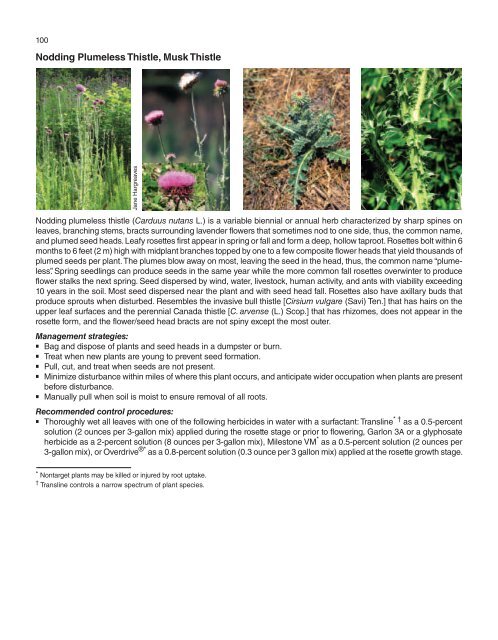A Management Guide for Invasive Plants in Southern Forests James ...
A Management Guide for Invasive Plants in Southern Forests James ...
A Management Guide for Invasive Plants in Southern Forests James ...
- No tags were found...
Create successful ePaper yourself
Turn your PDF publications into a flip-book with our unique Google optimized e-Paper software.
100Nodd<strong>in</strong>g Plumeless Thistle, Musk ThistleJane HargreavesNodd<strong>in</strong>g plumeless thistle (Carduus nutans L.) is a variable biennial or annual herb characterized by sharp sp<strong>in</strong>es onleaves, branch<strong>in</strong>g stems, bracts surround<strong>in</strong>g lavender flowers that sometimes nod to one side, thus, the common name,and plumed seed heads. Leafy rosettes first appear <strong>in</strong> spr<strong>in</strong>g or fall and <strong>for</strong>m a deep, hollow taproot. Rosettes bolt with<strong>in</strong> 6months to 6 feet (2 m) high with midplant branches topped by one to a few composite flower heads that yield thousands ofplumed seeds per plant. The plumes blow away on most, leav<strong>in</strong>g the seed <strong>in</strong> the head, thus, the common name “plumeless”.Spr<strong>in</strong>g seedl<strong>in</strong>gs can produce seeds <strong>in</strong> the same year while the more common fall rosettes overw<strong>in</strong>ter to produceflower stalks the next spr<strong>in</strong>g. Seed dispersed by w<strong>in</strong>d, water, livestock, human activity, and ants with viability exceed<strong>in</strong>g10 years <strong>in</strong> the soil. Most seed dispersed near the plant and with seed head fall. Rosettes also have axillary buds thatproduce sprouts when disturbed. Resembles the <strong>in</strong>vasive bull thistle [Cirsium vulgare (Savi) Ten.] that has hairs on theupper leaf surfaces and the perennial Canada thistle [C. arvense (L.) Scop.] that has rhizomes, does not appear <strong>in</strong> therosette <strong>for</strong>m, and the flower/seed head bracts are not sp<strong>in</strong>y except the most outer.<strong>Management</strong> strategies:Bag and dispose of plants and seed heads <strong>in</strong> a dumpster or burn.Treat when new plants are young to prevent seed <strong>for</strong>mation.Pull, cut, and treat when seeds are not present.M<strong>in</strong>imize disturbance with<strong>in</strong> miles of where this plant occurs, and anticipate wider occupation when plants are presentbe<strong>for</strong>e disturbance.Manually pull when soil is moist to ensure removal of all roots.Recommended control procedures:Thoroughly wet all leaves with one of the follow<strong>in</strong>g herbicides <strong>in</strong> water with a surfactant: Transl<strong>in</strong>e * † as a 0.5-percentsolution (2 ounces per 3-gallon mix) applied dur<strong>in</strong>g the rosette stage or prior to flower<strong>in</strong>g, Garlon 3A or a glyphosateherbicide as a 2-percent solution (8 ounces per 3-gallon mix), Milestone VM * as a 0.5-percent solution (2 ounces per3-gallon mix), or Overdrive ®* as a 0.8-percent solution (0.3 ounce per 3 gallon mix) applied at the rosette growth stage.* Nontarget plants may be killed or <strong>in</strong>jured by root uptake.† Transl<strong>in</strong>e controls a narrow spectrum of plant species.
















